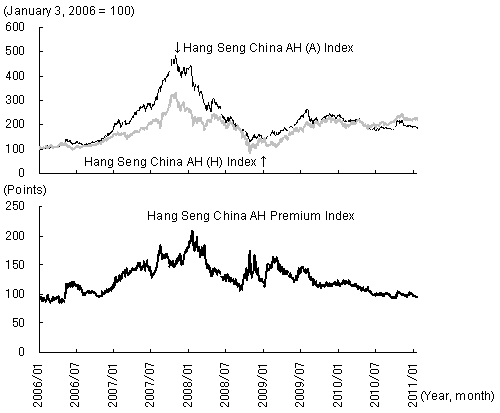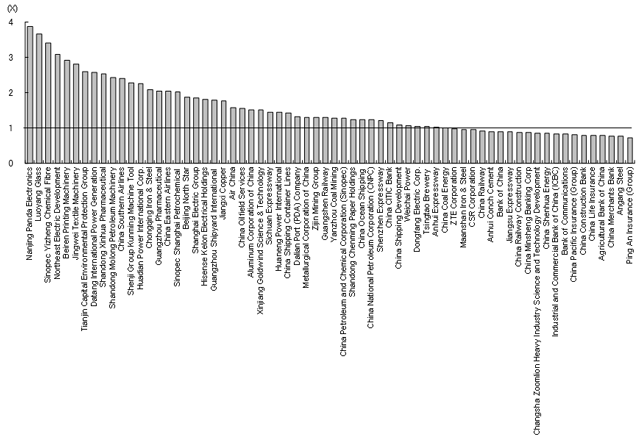As of January 19, 2011, 66 Chinese companies have listed their shares on the mainland market (Shanghai and Shenzhen) as A shares and simultaneously on the Hong Kong market as H shares. However, as the two markets are divided by capital controls in the mainland, the prices of A shares and H shares do not necessarily conform, and their relative prices are constantly changing. When share prices in the mainland reached bubble levels in 2007 and 2008, the prices of A shares of these companies significantly exceeded the prices of H shares, but differences have subsequently been narrowing, following the bursting of the bubble. As the Hang Seng China AH Premium Index indicates, the average price of A shares and that of H shares have been reversed since the beginning of 2011, with A shares now cheaper than H shares.
The mainland and Hong Kong markets are divided by capital controls
Although there is a difference between A shares and H shares, in that the former is traded in yuan while the latter in Hong Kong dollars, shareholders' rights such as entitlement to dividends and voting rights are the same for the both shares, as long as they are issued by the same companies. If capital flows were completely free between the Hong Kong market and the mainland market, investors would be able to earn a margin by purchasing shares in the cheaper market and selling them in the more expensive market, if there was any variance in share prices between the markets. This arbitrage activity would continue until share prices in both markets become identical.
In reality, however, as mainland China is still imposing strict capital controls, the mechanism described above does not function properly. Although it is true that foreign investors are allowed to purchase A shares through the Qualified Foreign Institutional Investor (QFII) system, the authorized limit as of the end of September 2010 is only 19 billion dollars, around 0.5% of the market capitalization of the A shares market. Meanwhile, domestic investors in China can buy foreign financial instruments through the Qualified Domestic Institutional Investor (QDII) system. However, as the investment vehicles under the QDII system include equities and bonds in overseas markets other than H shares, actual investment in H shares by domestic investors makes up a small part of their authorized limit (66.9 billion dollars as of September 2010, equivalent to approximately 10% of the market capitalization of the H shares market). Therefore, its impact on the H shares market is limited.
As arbitrage activities between the markets are heavily restricted, it is quite common for the prices of A shares and those of H shares to differ significantly, even for the same companies. As of January 19, 2011, of Chinese companies that have listed their stock in Hong Kong and the mainland at the same time, 45 have prices of their A shares higher than those of their H shares, while the remaining 21 companies have A shares selling more cheaply than their H shares (Figure 1). The price of A shares of Nanjing Panda Electronics, which has the highest relative price of A shares to H shares is at 3.9 times the price of H shares, while the price of A shares of Ping An Insurance, with the lowest relative price, is only 71.9% the price of H shares.
| Figure 1: Relative Prices of A Shares to H Shares (as of January 19, 2011) | |
| (Note) | As A shares and H shares are traded in yuan and the Hong Kong dollar, respectively, the relative prices are calculated by converting the prices of A shares and H shares into the same currency unit. |
| (Source) | Prepared by Chi Hung KWAN, based on data of Shanghai Wind Information. |
Movement of the Hang Seng China AH Premium Index draws attention
A typical index that shows the relative price of A shares to H shares is the Hang Seng China AH Premium Index (the "AH Premium Index"). This index is the weighted average of the relative prices of A shares to H shares for major companies that are listed on the mainland and Hong Kong markets at the same time (44 companies as of January 2011) (the larger the market capitalization of a company, the heavier its weighting becomes). The AH Premium Index is above (below) 100 when the price of A shares is in excess of (less than) that of H shares, and becomes 100 when the both are the same.
The AH Premium Index works as a reference to see how much A shares differ from the "fair valuation." This is because the A shares market is more speculative than the H shares market and tends to differ from fair valuation, given that the main players in the A shares market are individual investors in China, while the major participants in the H shares market are foreign institutional investors who focus on fundamentals such as interest rates and corporate earnings.
Reflecting these characteristics of the two markets, prices of A shares tend to rise more sharply than that of H shares (the AH Premium Index goes up) during bull markets, while it tends to fall more significantly (the AH Premium Index goes down) during bear markets, even though both prices are linked (Figure 2). More specifically, the AH Premium Index had been rising since 2006 along with prices of A shares and H shares, exceeding 200 temporarily at its peak in January 2008. However, this situation—which can be called a bubble—did not last long, and the AH Premium Index turned down along with prices of A shares and H shares. It has remained in a range centering on 100 after it dipped below 100 on June 18, 2010.
| Figure 2: Hang Seng China AH Premium Index linked to Prices of A Shares and H Shares | |
 | |
| (Note) | The Hang Seng China AH (A) Index is in the yuan, while the Hang Seng China AH (H) Index is in the Hong Kong dollar. |
| (Source) | Prepared by Chi Hung KWAN, based on Bloomberg data |
However, the fact that the AH Premium Index has been staying around 100 on the mainland market does not necessarily mean that an arbitrage relationship has been established between the mainland market and the Hong Kong market, because while the establishment of an arbitrage relationship is a sufficient condition for the AH Premium Index to become 100, it is not a necessary condition. For example, if the prices of A shares of some companies substantially exceed the prices of their H shares, while the prices of A shares of other companies are below the prices of their H shares, the price differences between the two can be netted out. This is exactly what is happening at the moment. In fact, as discussed earlier, as large price differences between A shares and H shares remain in individual companies, it is obvious that an arbitrage relationship has not been established between the markets.
As long as capital controls are maintained in the mainland market, it is hard to see the AH Premium Index staying at around 100 as it is now. With share prices in a sluggish period, the level of the AH Premium Index (94.8) as of January 19, 2011 is around 24.5% lower than the average (125.6) since January 2006. This indicates that A shares are undervalued. Based on past rule of thumb, the prices of A shares are likely to rise at a faster pace than those of H shares in the next bull market.



